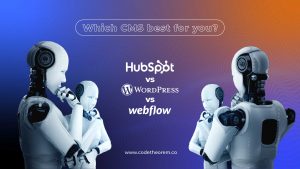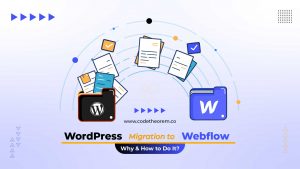Having a fully-functional website is a need central to most businesses. It must be a top priority for those who wish to have a robust online presence. Your website will play a crucial role in conversion optimization. It tells your customers who you are and what you do. Consequently, you must choose a platform that helps you customize your website to great depth. WordPress is one such popular platform in the realm of website development. It is easy to use, given that you understand the ins and outs of WordPress development best practices.
As a WordPress developer, you must start using this site responsibly by establishing excellent WordPress development habits. As you advance in this Content Management System and further strengthen your WordPress development abilities, this will immensely benefit your profession.
This blog will walk you through the following aspects of WordPress website development:
- Why should you prioritize user experience during WordPress website development?
- Importance of following WordPress coding standards
- Best practices for writing WordPress coding
- Best practices for structuring code in WordPress development and more.
When it comes to best practices for WordPress Development, nothing beat the checklist mentioned below. It covers development, design, user experience & security.
Article content
WordPress Development Best Practices Checklist
- Prioritize User Experience
- Follow WordPress Coding Standards
- Best Practices for Writing Code in WordPress
- Best Practices for Structuring Code in WordPress
- Select Plugins Wisely
- Ensure Security
- Testing Code in WordPress
1.) Prioritize User Experience
Website design is one of the most crucial facets of WordPress website development. And as a developer, you must start looking beyond the aesthetics during the WordPress development of your website if you do not already. Because a website is more than just its aesthetics. Your website design must balance three things:
- Content
- User Experience
- Business Goals
Out of these three, user experience is perhaps slightly more critical than the other two. You may wonder why? Because who are you building your website for? If your users are not comfortable navigating through your WordPress website, all your resources – time, money, and efforts are out for a toss.
Another critical aspect of user experience in WordPress development is your website’s compatibility with different screens, platforms, and devices. Regardless of where the users open your website, their experience should be flawless. And this will only be possible if your website design is responsive. For this, you can use responsive WordPress themes. WordPress themes are time-saving, providing you with an aesthetic design and an SEO edge since mobile-friendly websites are known to rank higher. As for the content part of your WordPress website, make it easily accessible to your users. Label everything neatly to reduce website bounce rates.
2.) Follow WordPress Coding Standards
In the WordPress handbook, WordPress coding standards are divided into 4 parts, depending on the language. They are as follows:
These coding standards were created with an intention. They are your building blocks. It is a common starting point, enabling those in the community to work together in the areas of WordPress plugins, themes, and core coding. Furthermore, these standards help minimize errors and increase readability.
It makes sense to write a code such that any part of code can be studied and amended, regardless of when and by whom it was produced, given that the platform is a collaborative Content Management System.
3.) WordPress development best practices for Writing Code
Readability
Ensure your code is readable by adhering to the WordPress development coding standards. It will help you write clear, consistent codes that can be understood easily by anyone in the team or community. Also, ensure that your code can flawlessly perform the same thing with the help of WordPress APIs.
Reliability
Two things that directly impact reliability are the longevity and maintainability of your code. Your website development project will likely fail if your codes are not maintainable once the original author is not around. Why? You won’t have anybody else to oversee continuity and assure upkeep.
Take it upon yourself to go beyond the basic requirements to create robust yet readable codes. And the best way to go about it is by charting out a plan that reflects all your problem statements in an organized fashion. This will enable simple cross-platform adaptation and a mechanism for reusable codes.
Ensure that your codes are simple to read as well. Develop precise naming rules for functions, classes, and variable names. Develop abstract code instead of inserting code snippets; package the codes as distinct WordPress plugins. This will improve the reusability of your codes, making them more reliable.
Flexibility
Flexibility is another vital practice in writing codes, especially for a WordPress development company. Your codes have to be editable whenever necessary. This gives you adequate freedom to expand.
Prevent having an out-of-date website by keeping an eye on updates and continuously making the necessary modifications to your WordPress development coding. Use relative URL paths wherever possible for this. This will ensure that you won’t need to modify all of your scripts if you decide to change the site URL. To improve flexibility, you may add action and filler hooks to allow others to use and add what you’ve already built.
4.) WordPress development best practices for Structuring Code
A well-structured code is easy to find and read. Furthermore, it is consistent. Following are some best practices for structuring your codes for WordPress development:
File and Directory Structure
Understanding the default file and directory structure hierarchy will help you know where exactly you should place your code during WordPress development – what is the correct location. The root directory of your website will consist of some configuration files. Following are some of them:
- index.php file – homepage of your website
- wp-config.php file – essential configuration settings for WordPress
- .htaccess file – gives your web server configuration rules.
The .htaccess file should consist of the default rules of WordPress. Furthermore, the root directory contains some other essential directories. Some of them are:
- wp-admin – contains WordPress core files that power the WordPress Admin Dashboard. Do not edit these files.
- wp-includes – contains most WordPress core files about the core functionality that helps your site tick. Do not edit these files either.
- wp-content – contains all user content that isn’t saved in the database. These include plugins, themes, and items uploaded to the media folder.
It is best to follow the recommended structure to keep similar files together within a plugin. Make sure that a single file has only one PHP class.
Template Hierarchy
Several components come together to create a cohesive whole during WordPress development. They fit like one big puzzle. And your WordPress development templates and file are used to create these different parts of a WordPress website. While some appear on all pages, others are more specific.
But how does WordPress decide which template to use? It is simple. WordPress follows a hierarchy. It keeps looking through its default template hierarchy until it finds a matching file name. In case there are multiple files, it uses the first one. And if the first one isn’t available, it used the second one, and so on.
To ensure that what you’re building uses the correct templates in suitable locations, you must acquaint yourself with this hierarchy and have a solid grasp of it.
Separation and Spaces
Separation and spaces may not create a functional difference. However, it can drastically improve the readability of your codes. They will ensure that the codes are at par and uniform during and after WordPress development. Following are some general practices that you can follow:
- Insert a space after a comma
- Put a space before beginning a parentheses
- Insert a space after closing the parentheses
- Avoid closing the PHP tag
- No whitespace at the end of the code
- Insert spaces around array items only when they are variable
You will find more standards for your PHP codes in the WordPress PHP Coding Standards.
Design Best Practices
Although WordPress has limited limitations on the aesthetics of your website, they do have suggestions for your CSS code structure. Some of them are listed below:
- Use tabs instead of spaces to indent
- CSS Sections should have two lines between each part
- List the selectors in their line with a comma or brace towards the end
- Separate name selectors in lowercase with a hyphen
- Add a colon or a space after a property
Go through the WordPress CSS coding standards to get more information on the best design practices. These suggestions will facilitate coordination and understanding while collaborating on the CMS platform.
5.) Select Plugins Wisely
You may choose from a wide range of third-party themes and plugins in your quest to optimize the material during WordPress development.
Choose the often updated ones that have received excellent user satisfaction ratings. Regular updates show that the plugin’s creator is devoted to maintaining compatibility with the most recent WordPress versions. They also increase your likelihood of getting assistance if you ever experience issues with their code.
Furthermore, do not go overboard with WordPress plugins. Adding too many will increase your website’s loading time, resulting in your users leaving the site.
6.) Ensure Security
The Internet is dangerous with undesirable access covers like spam comments and login attempts. Furthermore, bots can send excessive site traffic to take your website down. Consequently, it’s vital to ensure the safety of your WordPress website.
The following are some suggestions for keeping your website safe:
- Avoid simple usernames
- Avoid easy passwords
- Use Captcha or other filters
- Install security plugins like All In One WP Security & Firewall and iThemes Security
7.) Testing Code in WordPress
Test your code or perform basic debugging using an IDE or a debugger. IDE such as PHPStorm or a debugger like Xdebug can help WordPress developers.
Other ways include unit testing and quality assurance. In unit testing, individual pieces of code are tested, allowing you to identify if a recent change has broken the code making it easier to fix bugs. On the other hand, quality assurance ensures that your code is working correctly.
Moreover, rarely does the creation of a new feature, plugin, or child theme go perfectly the first time in development even after following WordPress development best practices. To ease the trial and error every time you deploy a new version or plugin, you can do automated testing by writing tests before writing a code.
Conclusion
WordPress for developers is an easy-to-use CMS platform. You can leverage several WordPress tools, template website design, WordPress themes, and more to create a fantastic, user-friendly website.
As an individual offering WordPress development services or a WordPress development company, you must stay up-to-date on the recent announcements, given that WordPress is constantly evolving. Doing so may ensure that you are informed of any new WordPress development features, security updates, or other elements that may impact your job.


















